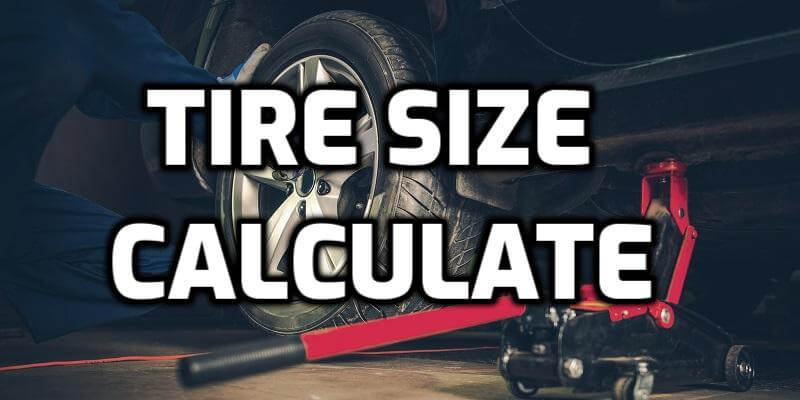How to Calculate Tire Size

Tires play a critical role in the performance, safety, and efficiency of your vehicle. To ensure you have the right tires for your car, it’s essential to understand tire size markings. This article will provide an in-depth look at the different components of a tire’s size marking, how to calculate tire dimensions and the importance of load and speed ratings.
Explanation of Tire Size Markings
Tire size markings can be found on the sidewall of your tire and typically consist of a series of letters and numbers, such as “225/50R17.” This combination of characters represents the following information:
- Section Width: The section width is the first number in the sequence, and it refers to the width of the tire, measured in millimeters. In this example, the tire has a width of 225 millimeters.
- Aspect Ratio: The aspect ratio is the second number in the sequence, representing the tire’s sidewall height as a percentage of its width. In this example, the tire has an aspect ratio of 50%.
- Tire Construction: The sequence’s letter indicates the tire construction type. In this case, the “R” stands for radial, the most common tire construction type.
- Wheel Diameter: The last number in the sequence represents the diameter of the wheel on which the tire is designed to fit. In our example, the tire is meant for a 17-inch wheel.
Sidewall Height
The sidewall height of a tire is the distance from the edge of the tire to the wheel. This measurement is taken in millimeters and can be found on the sidewall of the tire. The sidewall height is essential because it affects the size of the tire. A taller sidewall means that the tire is more significant, while a shorter sidewall means that the tire is smaller.
Now that we know the sidewall height let’s talk about how to calculate it. The sidewall height is calculated by multiplying the tire’s width by the aspect ratio. So, if you have a tire that is 225 millimeters wide and has an aspect ratio of 55, the sidewall height would be 225mm x 55% = 123.75mm.
Sidewall = Section Width × (Aspect Ratio/100)
Overall Diameter
The overall diameter of a tire is the distance from one side of the tire to the other. This measurement is taken in inches and can be found on the sidewall of the tire. The overall diameter is important because it determines the size of the tire.
A larger diameter means the tire is more prominent, while a smaller diameter means the tire is smaller. Now that we know the overall diameter let’s discuss how to calculate it. The overall diameter is calculated by multiplying the sidewall by two and adding the rim diameter. So the formula is
Diameter = (2 × Sidewall) + Rim Diameter
Tire Circumference
The circumference of a car tire is the distance around the outside of the tire. This measurement is also taken in millimeters and can be found on the sidewall of the tire. The circumference is important because it helps you determine the rolling diameter of the tire.
The rolling diameter is the distance the tire will travel in one revolution. This is important to know because it can affect the speedometer reading of your car. To calculate the circumference of your tire, you will need to know the tire diameter and Pi. To find the circumference, you will need to multiply the tire diameter by Pi, equal to 3.14.
Circumference =Tire Diameter × π
Revolutions Per Mile
Now that we know the circumference of the tire, we can calculate the revolutions per mile. This is the number of times the tire will go around in one mile. This measurement is important because it can affect the speedometer reading of your car. To calculate the revolutions per mile, you will need to know the tire’s circumference and your car’s mileage. The formula for this is
Revolutions per Mile = 63,360 ÷ Circumference
Construction Type
The construction Type of a tire is how the tire was put together. This can be found on the tire’s sidewall and is usually either “Radial” or “Bias.” The construction type is important because it can affect the performance of the tire.
Radial tires are usually made of softer compounds that can provide better grip. In comparison, bias tires are typically made of harder compounds that can provide longer tread life.
Wheel Size
The wheel size is the diameter of the wheel that the tire is mounted on. This measurement is taken in inches and can be found on the sidewall of the tire. You can find out the wheel size of your car by looking at the owner’s manual or tire sidewall. The last two number in the tire sidewall is the wheel diameter. The wheel size is important because it can affect the performance of the tire.
Conclusion
Understanding tire size markings, dimensions, and ratings is crucial for selecting the right tires for your vehicle. By decoding these markings, you can make informed decisions about tire width, aspect ratio, construction type, wheel diameter, and load and speed ratings.
With this knowledge, you can ensure that your tires provide optimal performance, safety, and efficiency, enhancing your overall driving experience

